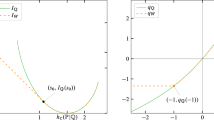Abstract
We first define a class of processes which we call regular quantum Markov processes. We next prove some basic results concerning such processes. A method is given for constructing quantum Markov processes using transition amplitude kernels. Finally we show that the Feynman path integral formalism can be clarified by approximating it with a quantum stochastic process.
Similar content being viewed by others
References
L. Accardi, “On the non-commutative Markov property,”Funct. Anal. Appl. 9, 1–12 (1975).
R. Cameron, “The Ilstow and Feynman integrals,”J. Anal. Math. 10, 287–361 (1962/63).
N. Dunford and J. Schwartz,Linear Operators Part I (Interscience, New York, 1958).
R. Feynman, “Space-time approach to non-relativistic quantum mechanics,”Rev. Mod. Phys. 20, 367–398 (1948).
R. Feynman and A. Hibbs,Quantum Mechanics and Path Integrals (McGraw-Hill, New York, 1965).
W. Garczynski, “On quantum stochastic processes,”Bull. Acad. Pol. Sci. 17, 775–779 (1969).
W. Garczynski and J. Peisert, “Some examples of quantum Markovian processes,”Acta Phys. Pol. B 3, 459–473 (1972).
S. Gudder, “Realistic quantum probability,”Int. J. Theor. Phys. 20, 193–209 (1988).
S. Gudder, “A theory of amplitudes,”J. Math. Phys. 29, 2020–2035 (1988).
S. Gudder,Quantum Probability (Academic Press, Boston, 1988).
S. Gudder, “Quantum probability and operational statistics,”Found. Phys. 20, 499 (1990).
S. Gudder and C. Schindler, “Regular quantum Markov processes,” to appear.
W. Guz, “Markovian processes in classical and quantum statistical mechanics,”Rep. Math. Phys. 7, 205–214 (1975).
R. Hudson, “Quantum stochastic calculus as a unifying force in physics and probability,” inThe Concept of Probability, E. Bitsakis and C. Nicolaides, eds. (Kluwer, Dordrecht, 1989), pp. 243–253.
W. Karwawski, “On Borchers class of Markov fields,”Proc. Cambridge Philos. Soc. 76, 457–463 (1974).
E. Nelson, “Construction of quantum fields from Markov fields,”J. Funct. Anal. 12, 97–112 (1973).
L. de la Pena-Auerbach, “A new formulation of stochastic theory and quantum mechanics,”Phys. Lett. A 27, 584–595 (1968).
M. Reed and B. Simon,Methods of Modern Mathematical Physics II: Fourier Analysis, Self-Adjointness (Academic Press, New York, 1975).
Author information
Authors and Affiliations
Rights and permissions
About this article
Cite this article
Gudder, S. Quantum stochastic processes. Found Phys 20, 1345–1363 (1990). https://doi.org/10.1007/BF01883490
Received:
Issue Date:
DOI: https://doi.org/10.1007/BF01883490



